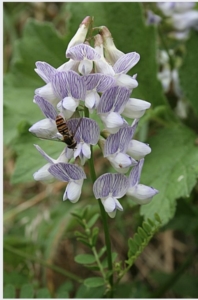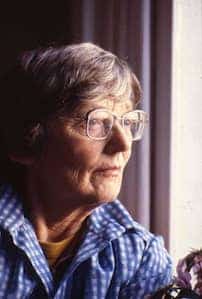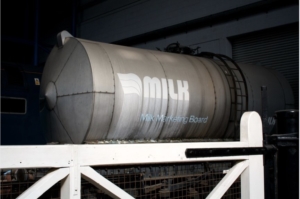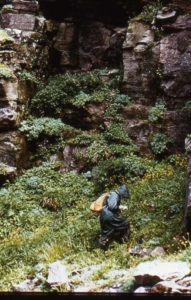Elaine R. Bullard
Botanist
Photograph of Elaine Bullard, taken by herself
(Provided by Sydney Gauld)
- BORN 11th May 1915, Greenwich, London, England
- DIED 10th August 2011, Kirkwall, Orkney, Scotland
- WORKED Dairy farms in various locations in England; Kirkwall, Orkney, Scotland; Many rural locations on all the inhabited and uninhabited Orkney Islands, Scotland; Rural locations in Caithness and in Sutherland, Scotland
- HONOURS MBE (New Year Honours) 1981; Honorary Doctorate in Science from Heriot Watt University (2007); Her death and achievements were noted in a motion to the Scottish Parliament (2011)
Entry by Catherine Booth
Acknowledgment: Grateful thanks both for help with the text and for most of the photographs to Sydney Gauld, Orkney Wildlife Information & Records Centre, who knew Elaine Bullard very well from his early childhood
Artistic Connections
Elaine loved Scottish dancing, so we assume she enjoyed Scottish dance music; Drew her own illustrations of plants; Was a good photographer – was a member of Orkney Camera Club and submitted photographs in their competitions

“In My Own Hands” – photograph taken by Elaine Bullard and entered in a Camera Club competition
(Provided by Sydney Gauld)
Music
Title: Tystie and the Primrose
Composer: FRANCES M LYNCH
Words by: Frances M Lynch
Written: Sept 2018 – Jan 2020
For: Solo Voice, speakers and flute
Performed by: Frances M Lynch (voice) with a pre-recorded track of the voices of Music Students from WICK HIGH SCHOOL and flute samples
First Previewed: Lyth Arts Centre, October 6th 2018
The music combines the work of work of two scientists whose work may at first glance seem unrelated: –
In the New Scientist in 1998 a study by Elaine Bullard was cited in an article which began:
The Scottish Birds Eye Primrose is confined to the extreme north coast of Caithness, Sutherland and Orkney; it is found nowhere else in the world. It risks extinction at many of its few remaining sites…… Her work on plants which extended through her long life is still valuable as an indicator of changes in land use and climate.
Today, at the Environmental Research Institute at North Highland College in Thurso, scientists study these changes in much the same way – searching and counting – only with more technology at their disposal! Concerned about a development of underwater turbines, Dr Elizabeth Masden is part of a team studying the characterful, but neglected Black Guillemot – know in Caithness as the Tystie.
PLEASE CLICK HERE FOR THE PDF OF THE TEXT
Education
After schooling in the south of England, Elaine Bullard completed a dairying course at College in Cornwall, where she initially gained certificates in buttermaking, cheesemaking, and the theory of dairying. Later she gained further dairying qualifications at Chelsea Polytechnic.
Botany, to which she devoted most of her life, was a science in which she had no formal qualifications, but which she taught herself by meticulous study and observation.
Occupations
Stockwoman
Working on farms, especially with dairy cattle
Women’s Land Army
Served in the Second World War
Milk recorder, employed by the Milk Marketing Board
Among other duties, Elaine Bullard would have travelled around farms, testing the yield and butterfat content of the milk produced by each dairy cow, and recording it. This helped to maintain national standards, but also provided the farmer with productivity information for each animal.
Laboratory technician
Claymore Creamery in Kirkwall, Orkney
Official Vice-County Recorder for Orkney for the Botanical Society of the British Isles (BSBI) 1963-2009
The British Isles are divided into geographical sub-divisions, vice-counties, for the purposes of gathering scientific data. Orkney is known as Vice-County 111 (VC111). The BSBI instigated a project in the 1950s to map the vegetation of the British Isles using Vice-County areas, and Elaine Bullard was a specified regional recorder for 46 years.
Botanist
Took early retirement to devote her life to study and catalogue the plant life of the Orkney Islands, as well as parts of Caithness and Sutherland. Provided invaluable assistance to visiting scholars and academics, and welcomed and informed curious amateurs, giving guided tours and talks and leading work parties.
Author of scientific botanical publications
Wrote many articles and papers for scientific publications, and contributed to several books edited by others.
Scientific Achievement
- Personally visited almost every inhabited and uninhabited island in Orkney to study the flora there – including precipitous cliffs and gullies, bogs, and rocks jutting out of the sea, as well as more hospitable landscapes. To establish any peculiarities of island species, she compared her findings with those relating to plants situated in Caithness and Sutherland on the mainland of Scotland
- Was meticulous in learning and using the Latin names for the plants she studied, and encouraged others to name them accurately too
- Produced many papers on botanical species over many decades, most notably on the Scottish primrose, Primula scotica – its distribution in Orkney and in Caithness and Sutherland, its habitat, its existing and extinct sites, its potential for restoration, and its conservation for the future
- Wrote and made valuable contributions to reference works, including the Natural history of Orkney (1985)
- Succeeded in her campaign for the establishment of the Orkney Biodiversity Records Centre where data could be collected and stored centrally, and made available to professionals and amateurs alike
- Was one of the founder members of the Orkney Field Club, and was its President for many years

Wood vetch,VIcia sylvatica, common in other parts of Scotland, but rediscovered in a Caithness location by Elaine Bullard in 1974
(by GeographBot licensed under CC BY-SA 2.0)
Did You Know?
Elaine Bullard lived very frugally, yet her work meant she spent many nights conducting research in rural areas away from home. She drove a Reliant Robin three-wheeled van, and adapted it with a tent attachment to serve as her accommodation.
She lived in a very small house, but had a garden which fascinated local children with its variety of trees, bushes and other plant life – not to mention the Call Ducks which she kept as pets.
An Inspiring Woman
The data collected by Elaine Bullard continues to be invaluable for researches into changing environments and climate change
She continued to work as the Official Recorder for the plants of Orkney until she was 93 years old – perhaps an inspiration to all of us not to give up something we love because of advancing age. She seems to have coped effortlessly with the move to computerised methods of recording data.
Her tenacity in carrying out the tasks she set herself is something we must admire. It cannot have been easy for her carrying out her research and observation in all terrains and weathers. We wonder how she coped with midgies!
Local Orkney people have spoken of how she inspired them to develop a lifelong interest in natural history. Her insistence on accuracy was also said to be a valuable lesson to younger members of her community.








